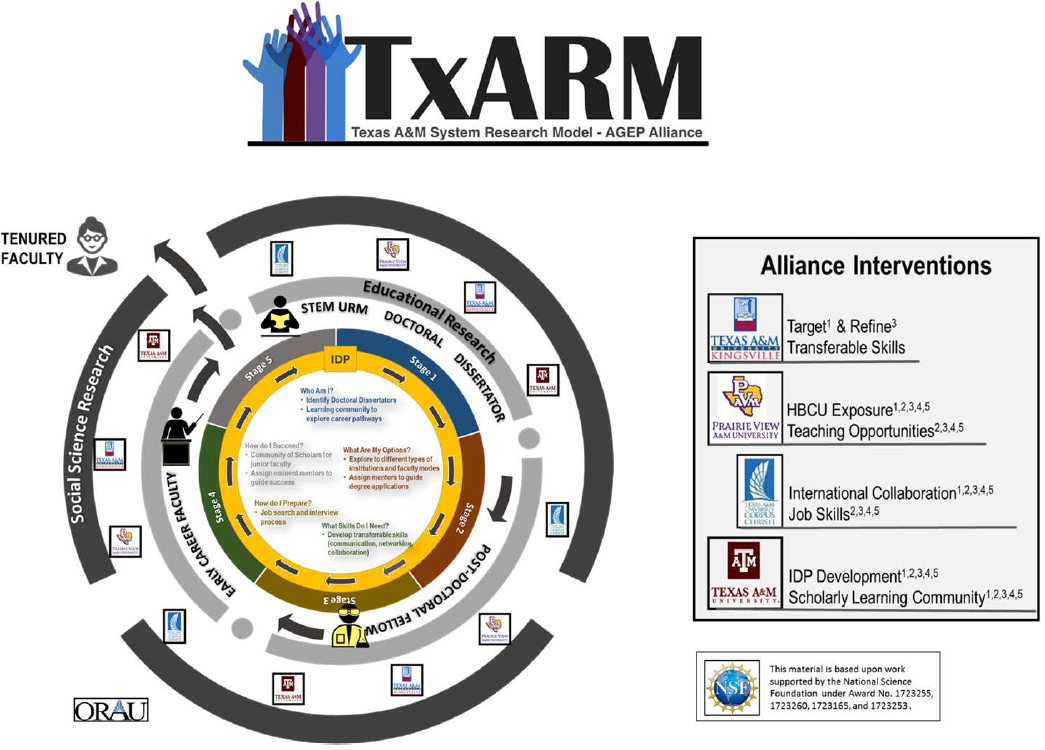AGEP II (TxARM)
TxARM AGEP Alliance at Texas A&M University
Texas A&M System Research Model (TxARM) - AGEP Alliance is a NSF-funded alliance between four Texas A&M System institutions. It aims to advance knowledge about models to improve pathways to the professoriate and success of historically underrepresented minority (URM) graduate students, postdoctoral fellows and faculty in specific STEM disciplines and/or STEM education research fields.
A Model to Advance Historically Underrepresented Minorities in the STEM Professoriate
This alliance was created in response to the NSF's Alliances for Graduate Education and the Professoriate (AGEP) program solicitation (NSF 16-552). The AGEP program seeks to advance knowledge about models to improve pathways to the professoriate and success of historically underrepresented minority (URM) graduate students, postdoctoral fellows and faculty in specific STEM disciplines and/or STEM education research fields.
The TxARM project is also funded by the NSF Research Traineeship Program (NRT) and the NSF's Historically Black Colleges and Universities - Undergraduate Program (HBCU-UP).
$2,816,700
Addressing URM Representation in Stem Higher Education
As the nation addresses a STEM achievement gap between URM and non-URM undergraduate and graduate students, our universities and colleges struggle to recruit, retain and promote URM STEM faculty. Minority representation in STEM faculty is important because URM faculty can serve as role models and academic leaders for URM students to learn from, work with and emulate.
Recent NSF reports indicate that URM STEM associate and full professors occupy 8% of these senior faculty positions at all 4-year colleges and universities and about 6% of these positions at the nation's most research-intensive institutions.
#8%
National Science Foundation
6%
National Science Foundation
The Texas A&M System AGEP Alliance has potential to advance a model to improve the success of URM graduate students and post-doctoral scholars as they enter and advance in the STEM professoriate.
Participating Institutions
Universities opted to participate in a second project intended to develop, implement and study a model of STEM doctoral degree completion and the transition to successful postdoctoral fellowships and faculty careers for historically underrepresented minorities.
| Institution | Designation |
| Texas A&M University – College Station (TAMUCS) | Research I University and Lead Institution |
| Prairie View A&M University (PVAMU) | Historically Black College and University (HBCU) |
| Texas A&M University – Corpus Christi (TAMUCC) | Minority Serving Institution (MSI) |
| Texas A&M University – Kingsville (TAMUK) | Minority Serving Institution (MSI) |
Student Demographics
Participants are pursuing degrees in the following fields:
- Biomedical Engineering
- Chemistry
- Electrical and Computer Engineering
- Environmental Engineering
- Marine Biology
- Wildlife Science
Goals, Objectives and Outcomes
Goals
The goals of the Alliance are to help URM STEM Ph.D. dissertators and postdoctoral fellows build professional identities as future members of the professoriate, and to provide continued support and mentoring to help them succeed as junior faculty.
Objectives
The model development, implementation and testing focuses on a unique set of interventions, including:
- Using individualized development plans for participants as they transition from dissertator to postdoctoral scholar to faculty.
- Providing participants with professional development opportunities related to communication, writing, networking and job preparation/transition.
- Supporting participants with mentors at the institutional and field-specific expert levels.
- Offering participants opportunities to experience academic culture and activities at historically black colleges and universities.
The integrated research will address the effects of stigmatization on male and female adults who are non-STEM and STEM African Americans and Hispanic Americans.

Expected Outcomes
The expected outcome of the AGEP TxARM model is that all URM STEM dissertators will join the professoriate or post-doc ranks immediately following completion of their PhDs, and then those who enter the post-doc ranks will, within a three-year period, subsequently enter the professoriate.
